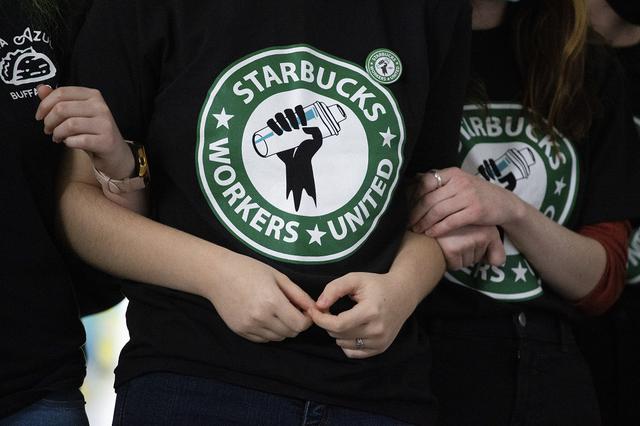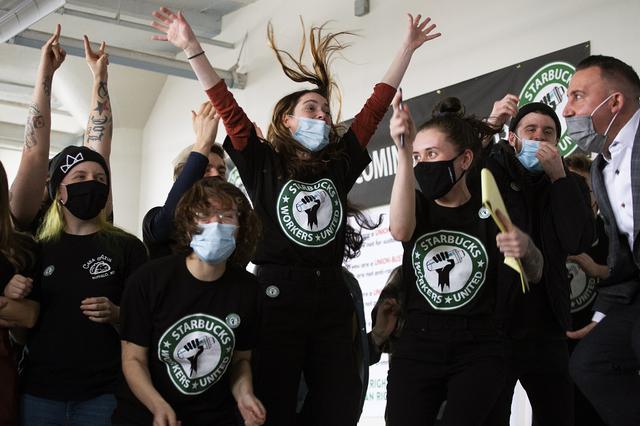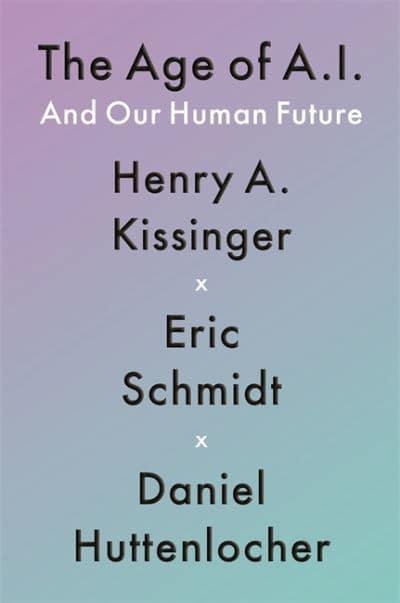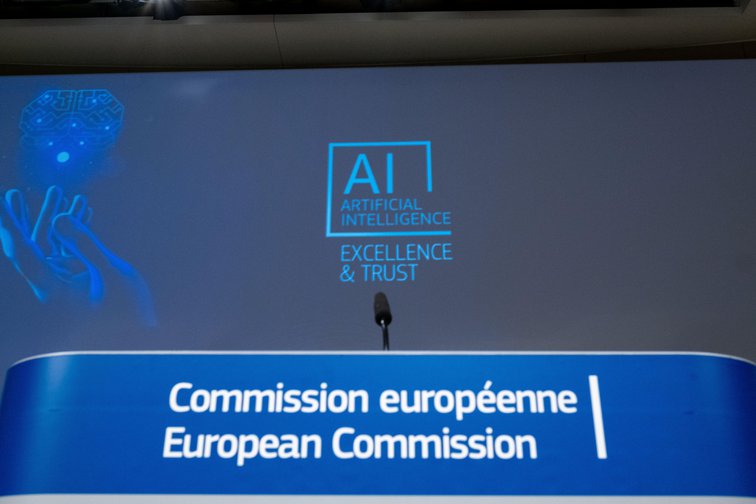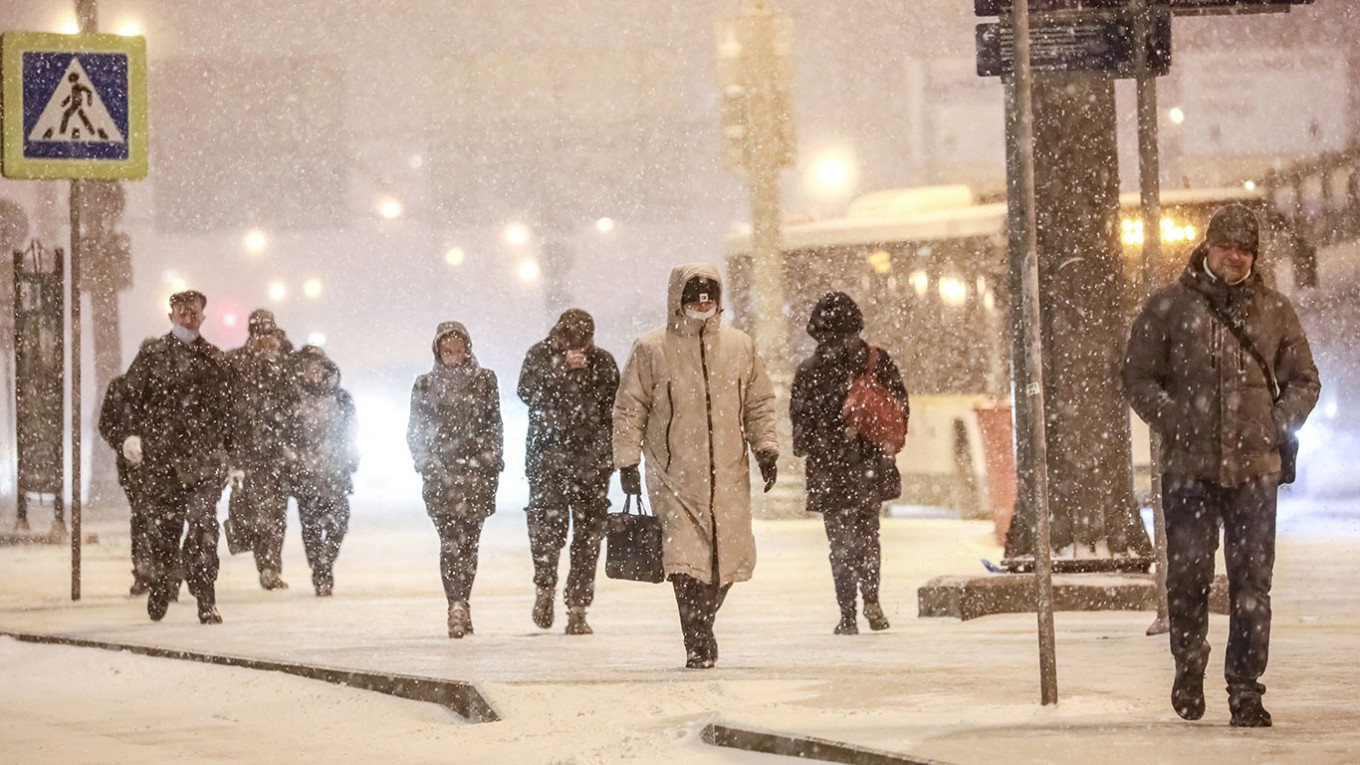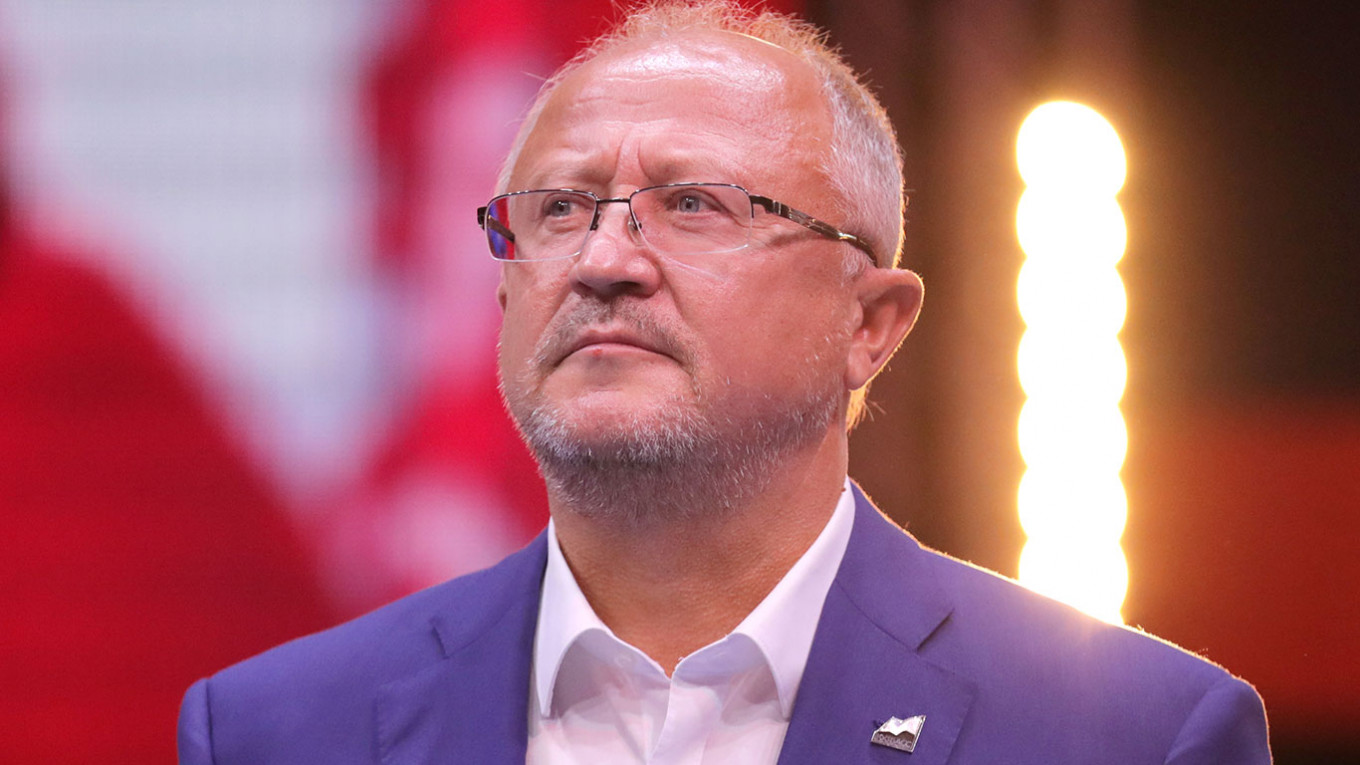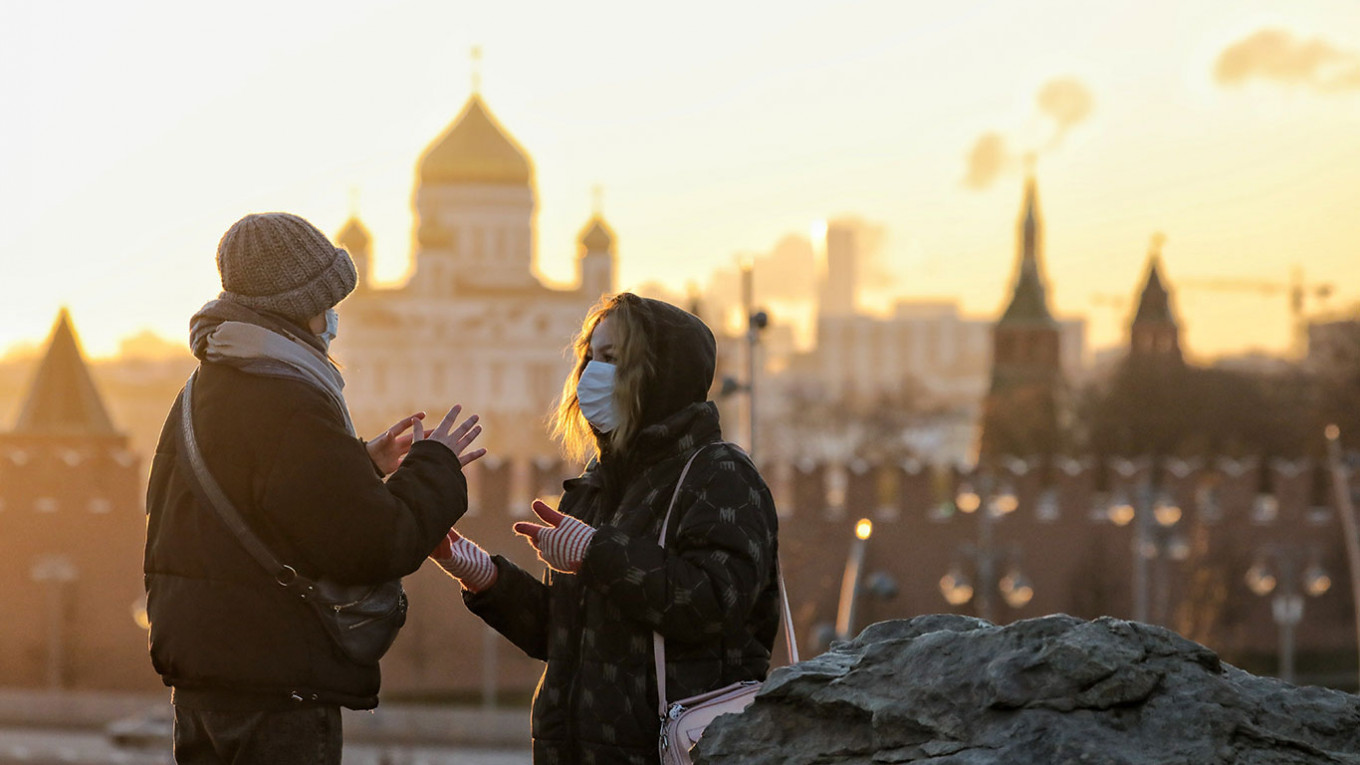With last week’s victory at the University of California, roughly 100,000 UAW members work for universities.
BY HAROLD MEYERSON
DECEMBER 16, 2021

KARLA COTÉ/SIPA USA VIA AP IMAGES
Students and faculty members of Columbia University rallied on December 6, 2021, in support of striking university workers. A student worker union won recognition in 2016, but a first contract between the students and the university has yet to be ratified.
While the media’s labor buzz last week was all about the vote of two dozen Buffalo baristas to unionize the Starbucks where they worked, that was hardly the only big labor story of the week. (And let’s pause to acknowledge that any media buzz about workers winning some power has been all too rare over the past three or four decades.)
There was also the ongoing struggle of bakery workers to win a contract at Kellogg that wouldn’t consign new hires to diminished pay and benefits (Bernie Sanders is headed to Battle Creek on Friday to rally the troops). Running third in the media’s eye was actually the nation’s largest unionization in several years: 17,000 research assistants at the University of California have joined the United Auto Workers (UAW). Despite the relative lack of buzz, that unionization more immediately pointed to a brighter future for the American labor movement than the victory at Starbucks.
I say that because organizing workers in the private sector has proved nearly impossible in recent decades. The evisceration of the National Labor Relations Act (NLRA) at the hands of the courts, and the pathological hostility of owners and managers to the collective bargaining of their employees, have compelled workers seeking to join or form unions to risk their jobs in the process—a risk that usually stalls such efforts in their tracks. It may be, as my colleague Bob Kuttner suggested on Monday, that macchiato-drinking consumers will put pressure on Starbucks not to oppose further efforts by their baristas to unionize. Indeed, a unionization effort at two Starbucks locations in Massachusetts popped up this week. But the equation on how many unsold lattes it will take to prod Starbucks to do the right thing has not yet been solved.
UAW officials estimate that with last week’s victory at UC, roughly 100,000 of the union’s 400,000 members are university employees.
The NLRA, however, doesn’t cover public-sector workers, an omission that has proved greatly to those workers’ benefit, at least in blue states like California. Under Jerry Brown’s first go-round as governor in the 1970s, California public employees were given the right to unionize. It turned out that their employers—usually state or municipal elected officials—weren’t as eager as private-sector bosses were to affront workers who were also voters. That’s the short answer to why fewer than 7 percent of the nation’s private-sector employees are unionized today, while the level of unionization in the public sector exceeds 30 percent.
That’s also one reason why unions like the United Auto Workers, rooted in a private-sector industry, began organizing in the public sector, where growth remained possible. Like most such unions, the UAW began the process on its home turf, organizing workers employed by Michigan’s state government and then employees at the UAW’s de facto home campus, Wayne State in Detroit (home of the Walter Reuther archives and other UAW collections).
But that doesn’t fully explain how grad students whom universities employ as teaching and research assistants across the nation were drawn to the UAW. Part of the answer is the UAW’s affiliation, over the course of the 1980s, of the independent left union known as District 65—a trailblazer in the union movement for such causes as civil rights and anti–Vietnam War activism. Progressive activist grad students both in New York City (where District 65 was headquartered) and in Berkeley had long admired District 65, and the synergies between those students and District 65 organizers led to a growing UAW presence on campus.
It took some time for that presence to reach today’s scale. UAW officials estimate that with last week’s victory at UC, roughly 100,000 of the union’s 400,000 members are university employees. Most are at public universities in states where public-employee collective bargaining was established by liberal state governments. In addition to the University of California (all ten campuses) and the Cal State University system, UAW campus locals also function at the University of Massachusetts, the University of Washington, and a range of other colleges.
The UAW is hardly alone in representing universities. The two major teachers unions have locals at public universities across the country, as do a host of other unions, which, like the UAW, found growth more possible in the public sector than in the private. With fully one-fourth of its members working for universities, however, the UAW may well have the highest share of grad student members of any American union.
Winning recognition for those locals has been anything but swift or automatic. Even when a state government enacted collective-bargaining rights for public employees, it took a while, often decades, for those rights to trickle down to the grad students and postdocs who perform much of the teaching and research on campuses. When Republicans took control of California’s governorship following Jerry Brown’s first departure in 1982, the process stalled until Democrat Gray Davis won in 1998, whereupon UC teaching assistants gained the right to unionize. Efforts to unionize UC research assistants then were put on hold during the governorship of Republican Arnold Schwarzenegger, but when Jerry Brown returned to office, the RAs won that right, abetted by a new system that enabled them to seek recognition when a majority of them had signed affiliation cards.
There are some ploys that non-university employers use to defeat unionization that won’t work with grad students.
Even so, UC President Michael Drake, in the dismal tradition of most American employers, withheld recognition until 97.5 percent of those signatories voted in late November to strike if not recognized. In addition, 30 Democratic members of Congress from California, led by Katie Porter of Irvine, sent a letter to Drake urging recognition. At that point, Drake caved, and the American union movement racked up its largest successful unionization campaign of the year.
The UAW not only represents employees at public universities, but also at a handful of prominent private universities, chiefly Harvard, Columbia, and NYU. For many years, the most venturesome and progressive region of the UAW (preceding even the District 65 affiliation) has been Region 9A, which covers New York and New England, and which began organizing private and public campuses many years ago. To win the right to organize grad student employees at private universities, however, required a ruling from the National Labor Relations Board (NLRB) that those students, when acting as TAs and RAs, were actually employees who were covered by the NLRA.
The students won such a ruling under the Clinton NLRB, saw it revoked by the Bush NLRB, reinstated by the Obama NLRB, hindered by the Trump NLRB, and are in the process of having it reconfirmed under the Biden NLRB. Their efforts have been fiercely opposed by university administrations, particularly at Columbia, where students won recognition in 2016, but where the administration has been so slow to negotiate that a first contract between the students and Columbia has yet to be ratified. (That’s one reason why grad students there are currently on strike, as my colleague Alex Sammon wrote about on Tuesday.)
There are some ploys that non-university employers use to defeat unionization that won’t work with grad students. First, while Amazon may be able to convince its workers that they’ll lose their jobs if they vote for a union, that’s a little harder to do at, say, Harvard, where the thousands of teaching and research assistants aren’t easily replaceable. Second, the latest Gallup poll showed that fully 77 percent of people aged 18-34, the cohort encompassing the age range of grad student workers, have a favorable view of unions. These combined factors create significant momentum for unionizing. One clear illustration of why grad students are so anomalous among private-sector workers is that when the Columbia grad students won their NLRB-run election in 2016, and when their Harvard counterparts won theirs in 2018, those were the largest NLRB election victories for any union in those respective years.
Last week’s addition of the RAs to the ranks of unionized UC grad students and postdocs means that total UAW membership at the nation’s most prestigious public university system now totals between 43,000 and 44,000, by the UAW’s estimate. That makes the University of California the fourth-largest employer of UAW members, exceeded only by General Motors, Ford, and Chrysler (which is now part of a company named Stellantis).
By sheer coincidence, last week’s victory coincided with a vote by UAW members to shift the way they elect their national officers, moving from a quadrennial convention of delegates elected by their locals to a rank-and-file vote of all individual members. In this, the UAW is following the Teamsters, and for the same reason: At the end of the 1980s, federal prosecutors put the Teamsters under federal trusteeship to cleanse the union of its pervasive corruption, and one element of that trusteeship required moving to rank-and-file elections. The trusteeship has since been lifted, but the Teamsters have opted to keep the elections.
The UAW’s 100,000 university employees, chiefly grad students, will have considerable influence over the course of what once was America’s greatest union.
In recent years, the UAW has seen a precipitous decline not just in size, as auto production has been outsourced to foreign lands and the non-union South, but also in the quality and honesty of its leaders. Federal prosecutors have won convictions against a host of high-ranking UAW officials, including two former presidents, for spending union funds on their own luxurious lifestyles. This year, the feds required the union to hold a vote of its members to see if they wished to switch to rank-and-file elections rather than delegated conventions, where some of the voting had been manipulated by self-seeking officials. In November, members voted overwhelmingly to make that switch.
That means the UAW’s 100,000 university employees, chiefly grad students, will have considerable influence over the course of what once was America’s greatest union. Roughly 160,000 UAW members now work at the Big Three auto assembly companies, and a smaller number work for parts plants and other links in the firms’ supply chains.
Over the course of the seven rank-and-file elections the Teamsters have held, turnout has seldom exceeded a quarter of the membership; it’s usually far lower. My hunch is that the turnout rate of the UAW’s autoworkers will exceed that of the Teamsters, but will likely lag behind that of the UAW’s university employees. There will be a clear generation gap: The median wage of unionized autoworkers hovers around 50, while the median age of grad students, even factoring in those who take forever to finish their dissertations, is at least two decades lower. Moreover, a higher percentage of grad students are women, and perhaps people of color, than is the case among autoworkers.
“I’m excited not just about welcoming new members from higher ed to the union,” Cindy Estrada, the UAW vice president for its university units, told the Prospect, “but also for the diversity of voices that will bring to the dialogue within the union.”
The UAW executive board consists of the president, secretary-treasurer, and several vice presidents, along with the leaders of the union’s roughly dozen regions, who will also now be elected by the rank-and-file members. At this point, the UAW’s westernmost region is numerically dominated by the grad students in California and Washington, which all but ensures more of the “diversity” that Estrada spoke of.
Perhaps this is all more fitting than it may at first seem. It was the UAW, after all, that lent its Port Huron campus to a group of student leftists in 1962, where they formed Students for a Democratic Society and drafted the Port Huron Statement. And while the UAW was slow to embrace the Vietnam anti-war movement (in 1967, Reuther backed the ineffectual halfway house of Negotiations Now), in the 1970s, particularly under the leadership of Reuther successor Doug Fraser, the union worked to rebuild a broad, transgenerational left.
Region 9A had embraced that position earlier, as I can personally attest. When I was an undergraduate at Columbia in 1970, I was part of a student group that was meeting in some dingy Morningside Heights basement to plan our participation in an upcoming massive anti-war demonstration. There was a knock on the door, and in walked someone we didn’t know, who didn’t appear to be one of us, as he looked to be in his forties. “I’m from the UAW,” he said. “What can we do to help?”
The intruder, who was to provide all kinds of major logistical help, was Ed Gray, then the deputy director (and later director) of Region 9A. Ed was one of the many Reutherite leaders who saw his mission as building a more social democratic America, which at the time required not just ending the Vietnam War, but building bridges between the Old Left and the New, between workers and students.
Half a century later, the UAW is back on campus—this time in force.

HAROLD MEYERSON is editor at large of The American Prospect.

